Laurel and Hardy
Compiled by Asim DEb
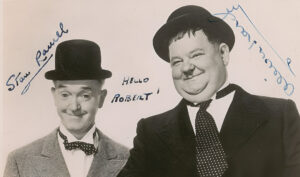
Arthur Stanley Jefferson, popularly known as Stan Laurel (June 16, 1890 – February 23, 1965) was born in Ulverston, Lancashire (now Ulverston, Cumbria), England. His father, Arthur J. “A.J.” Jefferson, was a showman and also an actor, director, playwright, and theatrical entrepreneur. At the age of 16, Laurel began his career in Glasgow Britannia Theatre of Varieties and Panopticon music hall, as a music hall comedian, and by 1910 he was understudying Charlie Chaplin in Fred Karno’s traveling comedy troupe. He gradually got chance in supporting roles until he became the featured comedian, as well as and understudy to Charlie Chaplin in Fred Karno’s comedy company. He emigrated to America in 1912 where he changed his name; as he was worried that “Stanley Jefferson” was too long to fit onto posters. He shortened it to “Stan” and added “Laurel” at the suggestion of his vaudeville partner, Mae Dahlberg.
Making his first film appearance in Nuts (May 1917). Then he acted in more than 50 silent films for various producers. At first, he experienced only modest success as a solo comedian, he did not have marketable screen character, like that of Chaplin, Harold Lloyd or Buster Keaton. It was only when Laurel began appearing in satires of popular screen dramas that audiences really took notice of him. Between 1922 and 1925 he starred in a number of films: Mud and Sand (1922) and Dr. Pyckle and Mr. Pryde (1925) (with Stan playing both the gentle doctor and the manic monster). However, in 1925 he had signed with Hal Roach Studios that his primary duties would be behind the cameras.
Norvell Hardy (January 18, 1892 – August 7, 1957) was born in Harlem, Georgia. As a tribute to his father (who died when Norvell was very young), he took his father’s first name (although not legally), henceforth calling himself “Oliver Norvell Hardy.” His offscreen nicknames were “Ollie” and “Babe.” His nickname “Babe” originated during his (pre-Laurel) early silent film career. Hardy had hair cuts at Italian barbershop near the Lubin Studios, Jacksonville, Florida. After cutting his hair and giving him a shave, the barber would then pat his face with talcum powder saying, “That’s nice a baby!” With the barber’s Italian accent, “baby” sounded like “Babe.” That nickname stuck with Hardy for the rest of his life and was billed as “Babe Hardy” in his early films. In some of the duo’s first silent films, Laurel can be seen mouthing the word “Babe” when calling out to Ollie.
By late teens, Hardy was a popular stage singer, and built his own movie house, the Palace Theater in Milledgeville, Georgia. In 1913, he joined Lubin Motion Pictures in Jacksonville, Florida, helping around the studio with lights, props and other duties. Around the same time, he married his first wife, Madelyn Salosihn.
In 1914, Babe acted in his first film Outwitting Dad. Between 1914 and 1916, Babe made 177 shorts, which were released till end of 1917. Babe was quite versatile, playing heroes, villains and even female characters. Hardy became much in demand for the next 10 years, with star actors Billy West, a Charlie Chaplin imitator, Jimmy Aubrey, Larry Semon and Charley Chase. In total, Hardy starred or co-starred in more than 250 silent shorts (about 150 of which have been lost).
How did Stan and Ollie get together in the first place?
By the time they worked in their first true Laurel & Hardy film, Ollie was already thirty-five and Stanley was thirty-seven. The first film pairing of the two, although as separate performers, took place in the silent film The Lucky Dog in 1921. In 1926, they had appeared again after they joined Hal Roach, and then their teaming began. At Roach the director Leo McCarey noted a comic contrast between them and encouraged their teamwork. They first appeared in something resembling their eventual format in a 1927 release called Duck Soup. (Here is one still picture from the movie Duck Soup).
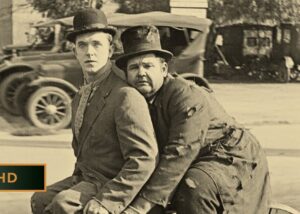
They appeared in the Hal Roach production 45 Minutes from Hollywood (1926). Their first “official” film together was Putting Pants on Philip, although their first pairing as the now familiar “Stan and Ollie” characters was The Second Hundred Years (June 1927). At that time Leo McCarey noticed the chemistry between “the thin one” (Laurel) and “the fat one” (Hardy). By the end of 1927 they become the member of official team. Their comedic formula was a combination of utter brainless stupidity and unhampered optimism, or, as Laurel himself described it, “two minds without a single thought.” Laurel was the guileless simpleton, the cause of most of their troubles, whereas Hardy was a self-important fastidious man whose plans always went awry because of his misplaced faith in both his partner and his own abilities. They always changed simple everyday situations into disastrous tangles by their acts. And the team could attain enormous popularity by the end of the silent era through comic gems such as Putting Pants on Philip (1927), Two Tars (1928), Liberty (1929), and Big Business (1929).
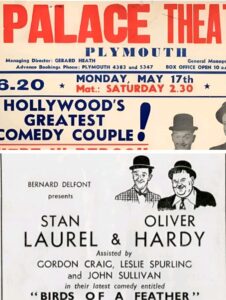
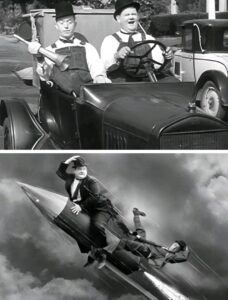
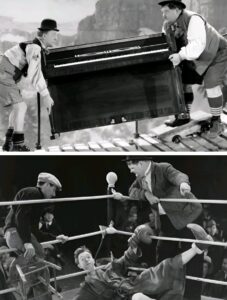
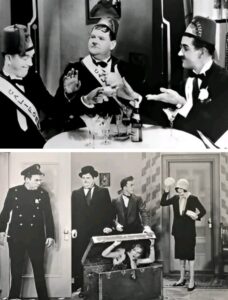
While most silent-film actors had their careers decline with the advent of sound, Laurel and Hardy made a successful transition in 1929 with the short Unaccustomed As We Are. Laurel’s English accent and Hardy’s Southern American accent and singing brought new dimensions to their characters. Then the first feature film starring them was Pardon Us in 1931. The following year The Music Box, won an Academy Award for Best Live Action Short Subject.
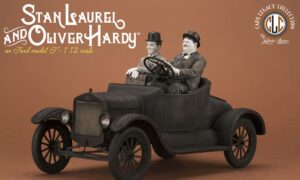
A number of their films were reshot with Laurel and Hardy talking in Spanish, Italian, French or German. The plots were similar to the English version although the supporting cast were often native language actors. They couldn’t speak any foreign language and received voice coaching to reproduce their lines. Pardon Us (1931) was reshot in all 4 foreign languages. Blotto (1930), Chickens Come Home (1931) and Below Zero (1930) had a French and Spanish version. These film versions helped to boost the duos popularity internationally. Finally, Laurel and Hardy, were regarded as the greatest duo comedians in film history. Between 1921 and 1950, they made more than 100 comedies, with Laurel playing the bumbling and innocent foil to the pompous Hardy.
On the development of motion-picture sound, Laurel’s British accent and Hardy’s Southern tones were perfectly suited to their characters, and Laurel devised several ingenious well-timed audio gags. Laurel had trademarks of frequent head-scratching, a whimpering cry, and a blank stare. On the other side, Hardy developed a vast array of eccentricities: flowery speech and mannerisms. They appeared in more than 40 sound shorts for Roach, including the classics Hog Wild (1930), Helpmates (1931), Towed in a Hole (1932), and the Academy Award-winning The Music Box (1932). Unfortunately never credited as such on the films, Laurel was the de facto director and head writer for virtually all of the team’s Roach comedies.
Largely out of economic necessity, the Roach Studios began to star Laurel and Hardy in feature films. They made their debut in Pardon Us (1931) and then 13 more through 1940. Their best full-length comedies were The Devil’s Brother (1933); Babes in Toyland (1934, re-released as March of the Wooden Soldiers), Our Relations (1936), Block-Heads (1938), A Chump at Oxford (1940). Their finest are Sons of the Desert (1933) and Way Out West (1937). Because of the dwindling market for short subjects, the team abandoned two reelers in 1935.
The importance of that artistic license became manifest in the 1940s, when Laurel and Hardy worked for Twentieth Century-Fox and Metro-Goldwyn-Mayer. As those studios denied the team their creative input to which they had become accustomed at Roach, their comedy suffered, and their films from the 1940s are regarded as their weakest works. They remained popular, however, with wartime audiences. Their final film was the European-produced Atoll K (1950; also released as Utopia and Robinson Crusoeland), after which they toured English music halls to great success. They remained an official team until Hardy’s death in 1957.
When their Hollywood career stalled in the 1940s Laurel and Hardy started to tour regularly in Britain. They called it quits in 1954 after an unsuccessful tour of Britain. In 1955, Laurel and Hardy made their final public appearance together in the program This Is Music Hall. This was a BBC Television program about the Grand Order of Water Rats, a British variety organization. During their eight months touring in England, Scotland and Ireland, they often performed to half-empty theatres. Hardy’s health was also getting worse. In what would become their final performance Hardy had a heart attack on stage. They made their final appearance on camera in 1956 in a private home movie, shot by a family friend at the Reseda, CA home of Stan Laurel‘s daughter, Lois. It contains no audio and is only three minutes in length.
In 1956, following his doctor’s orders to improve his health due to heart condition, Hardy lost over 100 pounds (45 kg; 7.1 st). However, he suffered several strokes that resulted in the loss of his mobility and speech. Hardy could not survive and died of a stroke on August 7, 1957, and longtime friend Bob Chatterton stated that Hardy weighed just 138 pounds (63 kg; 9.9 st) at the time of his death. And his partner in crime, Laurel, then never performed again after the death of his best friend. For the remaining eight years of his life, Stan Laurel refused to perform and even turned down Stanley Kramer’s offer of a cameo in his landmark 1963 movie
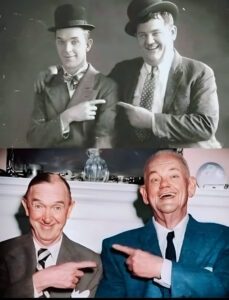
Laurel & Hardy, by the time of their teaming, they were approaching middle age and of course were becoming too valuable to risk. Stan Laurel was sometimes doubled by Ham Kimsey; Oliver Hardy’s usual double was Cy Slocum. It’s a Mad, Mad, Mad, Mad World. Laurel lived until 1965 and survived to see the duo’s work rediscovered through television and classic film revivals. He died on February 23 in Santa Monica. Despite having a long and successful career, it was reported that Hardy’s home was sold to help cover the cost of his medical expenses.
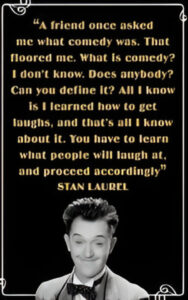
In 1960, Laurel was given a special Academy Award for his contributions to film comedy but was unable to attend the ceremony personally, due to his poor health.
Apart from the team’s success of 1932 Academy Award for the Best Short Subject movie, The Music Box; in 1935, Tit for Tat was also recommended for a nomination in the same category.
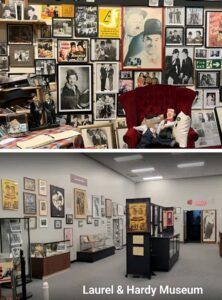
INTERESTING FACTS
• In 2005, they were voted the seventh-greatest comedy actors of all time by a UK poll of comedians.
• They appeared together in 107 films: (32 short silent films, 40 short sound films, and 23 full-length feature films). They also made 12 guest or cameo appearances that included the Galaxy of Stars promotional film of 1936.
• The duo’s signature tune is known variously as “The Cuckoo Song”, “Ku-Ku” or “The Dance of the Cuckoos”. It was played over the opening credits of their films and has become as emblematic of the duo as their bowler hats.
• The popular ‘Simpsons’ catchphrase, ‘D’oh!’ has its origins in the Laurel and Hardy films. It appeared in 33 of their films
• After Hardy’s death in 1957, Laurel put his number in the phone book so fans could contact him. He also replied to all his fan-mail by own handwritings.
• Despite a long and successful career (250+ movies to his credit), it was reported that Hardy’s home was sold to help cover the cost of his death-time medical expenses.
At one point, Stan Laurel had married his first wife once, his second wife twice, and his third wife three times. 1-2-3. Then he spoiled that arithmetic progression but created a different symmetry. He went back and again married his second wife, a third time, but that was not the end because he concluded the series by again marrying once, that was his fourth wife. So it was 1-3-3-1. What does this mean? TWICE TWO? Maybe TWICE THREE? You tell us. Perhaps Oliver Hardy had the answer in SONS OF THE DESERT when he said, “I never realized that such a deplorable condition existed in your home.” His marriage to actress Lois Neilson (1926-1936) had a daughter, Lois Jr., in 1927. Stan’s first wife sometimes served as his personal business manager and handled all of his business dealings with Hal Roach. His stormiest marriage to Illiana Shuvalova, a Russian opera singer, lasted only a year.
Oliver was married three times. His final marriage was with Lucille Jones, a script girl that he had met during the filming of The Flying Deuces. It lasted from 1940 until his death in 1957.
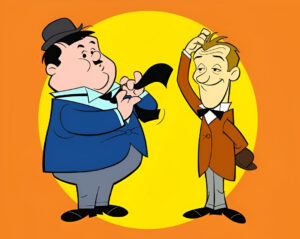
Source:
https://www.britannica.com/topic/Laurel-and-Hardy
http://www.laurel-and-hardy.com/
https://www.bbc.co.uk/newsround/46839097
https://www.bbc.com/news/uk-england
https://laurelandhardy.fandom.com
https://www.youtube.com/watch?v=bXBmUOjgWJE
Wikipedia
********

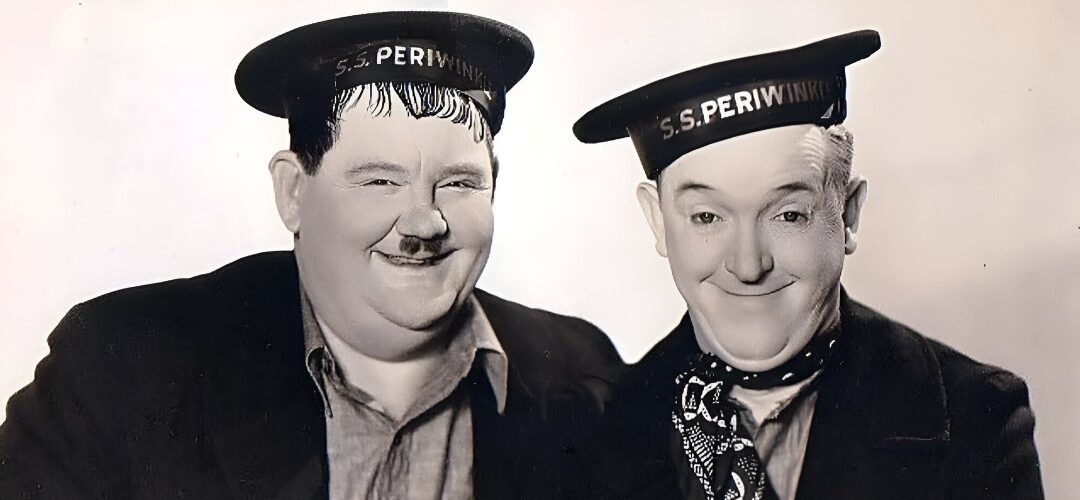
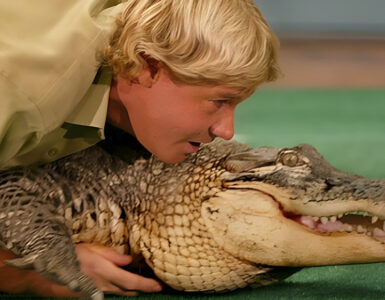
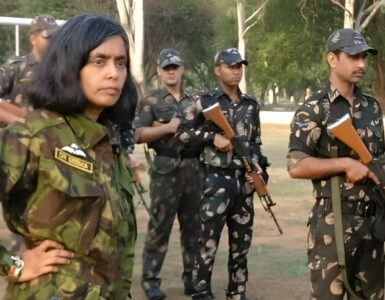










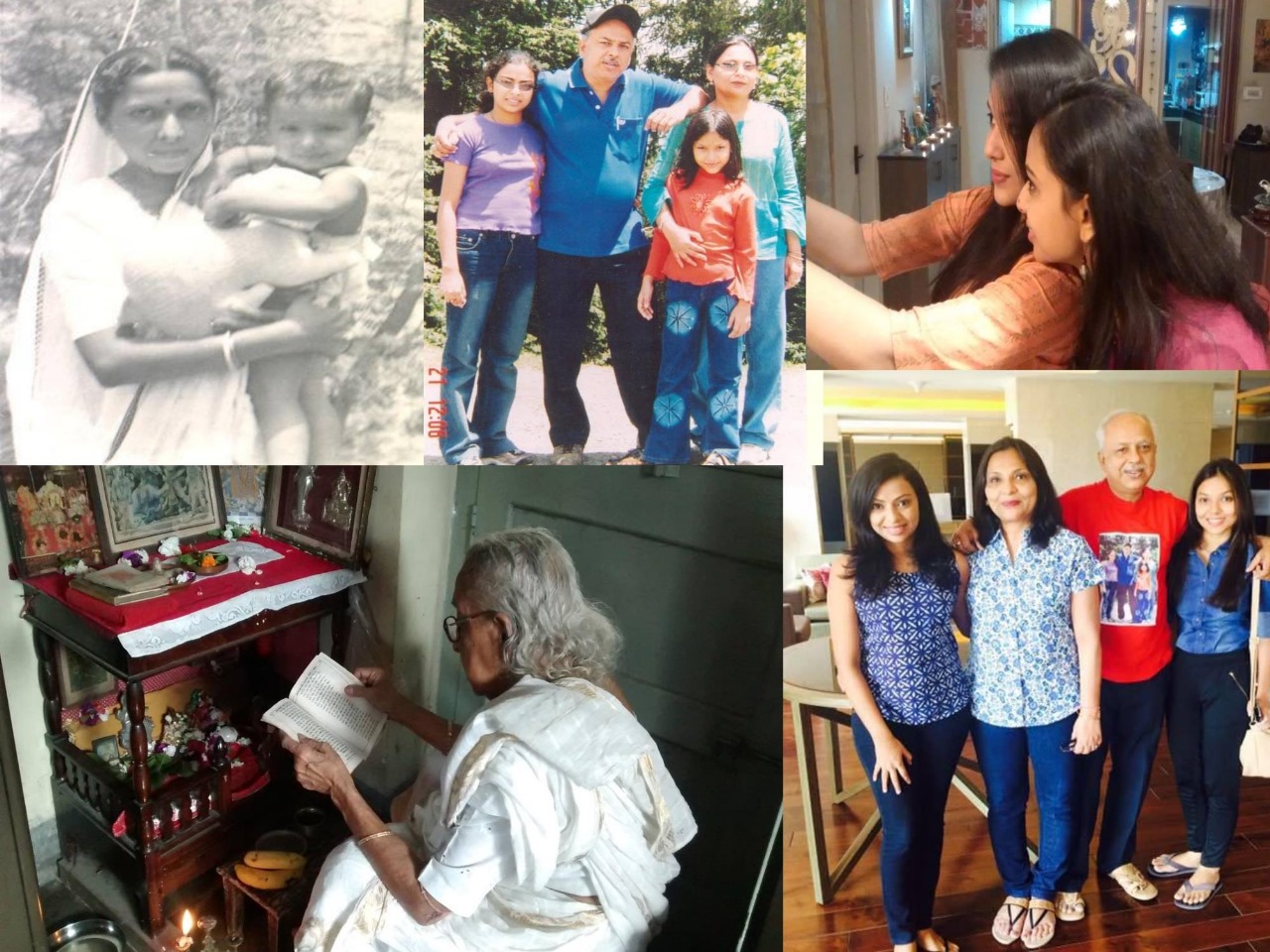
Another interesting one from you, Asim..
The duo is my all time favourite, with Chaplin. They ruled the era of silent movies.
You have drawn their career very nicely in simple words.
Thanks, once more.
I have seen many clippings of the duo. Now I read about their works, life and the grooming in film world.
Author has chosen an interesting subject,, nicely documented. It would be a delight for all the readers.
নির্বাক সিনেমা যুগের দুই অসাধারণ অভিনেতার জুটি। ছোট ছোট চুটকি রিল দেখেছি। শুধু অভিনয় দিয়েই গল্প এগিয়ে নিয়ে যেতেন।
লেখক অনেক যত্ন করে তাঁদের ব্যক্তিগত জীবনে আলোকপাত করলেন। সুন্দর উপস্থাপনা।
অনেক ধন্যবাদ জানাই।
A very bold initiative. Laurel and Hardy, both are famous for their silent roles in so many episodes. We are familiar with these two characters since our childhood. This is really praiseworthy that some one has taken the initiative to focus these two characters, after a long gap.
Nicely written article. Thanks to the author for his work to present brief like sketches of the duo who were highly popular during the era of silent cinema when creativity of the directors was dependent on movement of the actors to project the story/theme to the audience. I had seen some of clippings of the duo which were of nice entertainment values . Thanks once again.
আমার ছোটবেলায় বরানগর মিশনের হোস্টেলে প্রতি রবিবার সন্ধ্যে বেলায় সরকারি ডকুমেন্টারি ও লরেল হার্ডি জুটির ফিল্ম দেখানো হত।
বোকা বোকা কাজ করে মাথা চুলকোনো চোখ পিটপিট করা স্ট্যান লরেল ও ওকে ধমকে আরও ছড়িয়ে ফেলা অলিভার হার্ডিও কম নয়।
কোন আহাম্মুকি দেখলে বলা হত — এ তো পুরো লরেল হার্ডি কেস!
শুকতারা ম্যাগাজিন ও ওদের নিয়ে কমিক স্ট্রিপ বের করত।
কিন্তু ওঁদের জীবন , সময়কাল ও সংঘর্ষ সম্বন্ধে কিছুই জানা ছিল না।
অসীম দেব মশাইকে ধন্যবাদ! ওনার বিস্তারিত গবেষণা আমাকে অবাক করেছে, সমৃদ্ধ করেছে।
I had few collections of their comics, those were my childhood days. This article sends me to those forgotten era of mine, and I can vividly see those pages, those pictures..
It’s wonderful that now I could know many ins and outs of the duo.
Thanks for the author.
অসীম দেবের আরেকটি অসাধারণ লেখা। Laurel & Hardy র অনেক সিনেমা আমরা সবাই ছোট বেলা থেকে দেখে আসছি। কিন্তু ওদের সমন্ধে এতো কিছু জানা ছিলো না। এনারা সত্যি একেকজন লেজেন্ডরি। ওঁনাদের অভিনয় ক্ষমতা অসাধারণ। এই বয়সে পৌঁছেও এনাদের সিনেমা এখনো দেখতে ভালো লাগে। অসীম ওঁনাদের সমন্ধে প্রায় রিসার্চ ওয়ার্ক করে ফেলেছে এবং আমাদের ওনাদের সমন্ধে অনেক কিছু তথ্য দিয়েছে এই লেখার মাধ্যমে। বেশ পড়াশোনা করে অনেক তথ্য জোগাড় করে এই লেখাটা অসীম লিখেছে, তারজন্য অসীম কে অশেষ ধন্যবাদ। ❤🌹🙏🏽
পড়ে ভালো লাগলো।
অভিনয়ের বাইরে লরেল হার্ডি সম্বন্ধে কিছুই জানা ছিল না। এখানে লেখক বেশ পড়াশোনা করে গুছিয়ে লিখেছেন। ছোটর মধ্যে সুখপাঠ্য।
লেখককে অনেক ধন্যবাদ জানাই। এরকম আরও কিছু আশা করছি।
A very good read.
As actor of silent comedy I only knew about great Chaplin. Works of these two stalwarts were not known to me, honestly. Your write up has opened a new era of silent films to me.